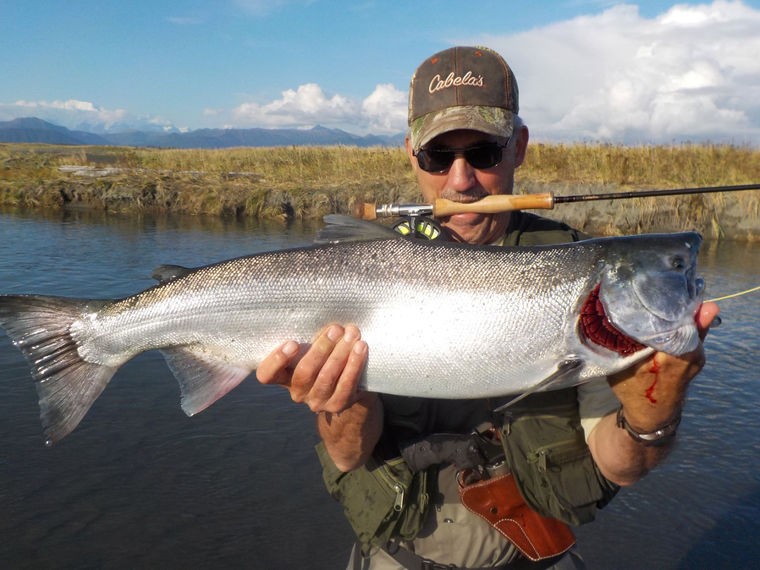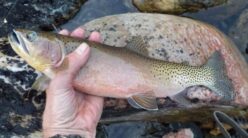Two weeks ago, we talked about salmon fishing in Alaska. This week let’s talk about how to catch them.
After the salmon enter the fresh water rivers, they quit feeding. Their whole purpose is to go upstream, spawn and then die.
You hear all kinds of theories as to why they hit since they’re no longer feeding. Most people theorize they’re not actually feeding but trying to pick up what they think is an egg sack floating down the river that they try to carry back to the nest. Because of this, a lot of us use pink flies, while some bait fishermen use egg sacks, because that explanation sounds plausible.
In a nutshell, I can’t tell you why they hit, but they do. So I’ll tell you what worked for us. Because we were fishing for silvers, that’s what I’m going to be talking about in this article.
We were using mainly pink flies or egg-sucking leeches. My buddy, Stan Tenza, says he uses a mouse fly now and then strips it across the stream, and it’s a blast catching them on top. He said they just slam it.
Most of the times I’ve gone to Alaska I’ve mainly been ocean fishing while hitting the rivers in the evenings. I’ve always used my 5-weight rod, but salmon will tear you up on a 5-weight. To me, a 10-weight is too unwieldy, but an 8-weight is too light.
So this year I got a Cabela’s 9-weight and it worked great. If you don’t have a big fly rod, you just aren’t going to be able to handle them. They’re going to tear you up and spool you. So my advice, buy a 9-weight.
Next, you’ll want a big reel. I got a Cabela’s Saltwater Prestige reel so I could also use it fishing for Reds in Louisiana. Because the rivers we were fishing weren’t more than 6 to 8 feet deep, I used floating line and a 9-foot leader. For tippet material, I used 15-pound test.
But salmon aren’t leader-shy. So you can tie your fly right onto your leader, but you’ll be tying on new leaders all day. So to me, it’s best to use some heavy tippet material.
Now that we’re set on gear, let’s talk about the fishing itself. Bright sunny bluebird days aren’t the best. The salmon are just a little too jumpy, which is understandable. If it’s bright, it’s easier for the seals, bears, wolves and eagles to jump in and grab them. I guess if I was the main attraction on the menu, I’d be a little nervous on sunny days, too. So we did best on overcast days.
I like to cast upstream a bit and strip my fly as it floats downstream. I don’t strip super-fast, but you don’t want to go too slow either. If it is lazily floating along, they have time to study it and know something is fishy. So you want to strip it slow enough so it doesn’t zip past them fast enough that they don’t see it. But it should be fast enough so it worries them that it’s going to get away if they don’t attack fast.
When they hit, you’ll know it. Not all, but many go airborne and do cartwheels. I had one do four to six cartwheels, so that’s fun. And they have some power. They will haul.
I was raised using my pointer finger and thumb to strip line and fight trout, but on salmon they’ll burn your fingers up. I’ve caught pinks and dogs before, but never silvers on a flyrod. I’d try to palm them, but invariably they’d zip off. And the handle would beat my fingers to a pulp before I was fast enough to move my hand.
One night I walked into the lodge and they were discussing how they fought salmon. There were two Canadians who were super good fly fisherman, and one of them leaned over to me and said, “I never palm my reel, do you? That’ll beat your fingers to death. I just tighten my drag to reel them in.”
I replied, “Oh yeah, only a real idiot would try to palm his reel. That’d whack the heck out of your fingers.” Ever since that conversation, I’ve used my drag to fight big fish.
Of course it goes without saying that you’ll want a big dip net to land your fish, and it’s best if someone is netting for you.
Well hopefully that’s enough advice to help you get jump-started. If you want the silver trip of a lifetime, give Alaska Expedition Co. a call at 800-572-0980. Have fun.
Tom Claycomb lives in Idaho and has outdoors columns in newspapers in Alaska, Idaho, Utah, Nevada, Colorado and Louisiana. He also writes for various outdoors magazines and teaches outdoors seminars at stores like Cabela’s, Sportsman’s Warehouse and Bass Pro Shop.



